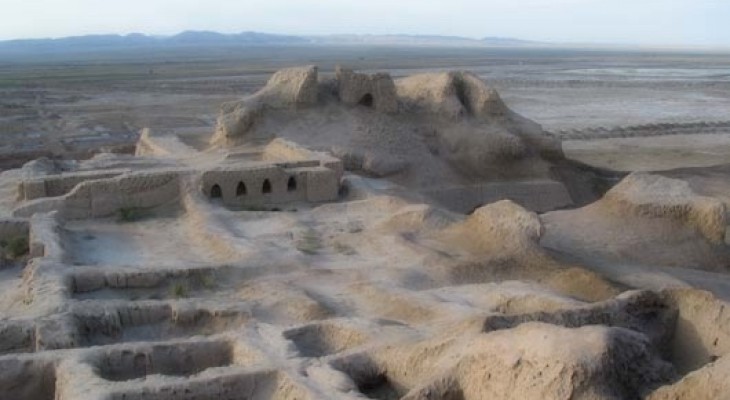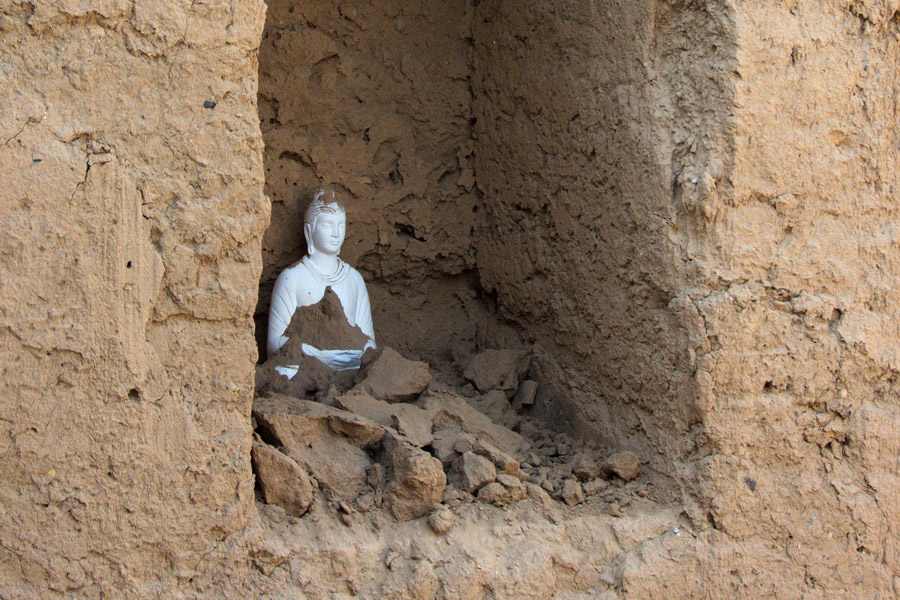The architectural ensemble of Sultan-Saadat is located on the outskirts of the city of Termez, in the center of Surkhandarya region of Uzbekistan. The memorial complex consists of the tombs of representatives of the dynasty of Termezseyids, considered to be the direct descendants of the Prophet Muhammad.
The architectural ensemble of the complex was formed during the XI – XVII centuries and includes various memorial and religious buildings. Despite the different times of construction, all buildings have a similar stylistic design. The facades are decorated with curly brickwork of burnt bricks, which also served as a material for the supporting structure. In the XV century, the arch of the entrance portal was faced with majolica tiles.
In the XIX century, the buildings of the complex gradually disintegrated and came to desolation. In 2005, the ensemble of mausoleums of Sultan-Saadat was solemnly opened after the completion of the restoration works. Currently, this majestic memorial complex is open to all comers.

Ancient settlement of Erkurgan
The settlement of Erkurgan is the remains of an ancient city, located ten kilometers from the modern city of Karshi. The first settlement was founded here in the 9th-8th centuries BC. Later on this territory appeared a fairly large for its time city, existing before the X century AD.
From the raids of the nomads, the city was defended by two rows of defensive walls. According to the inscriptions on the coins found during the excavation, the scientists established that the city that existed here bore the name Kasan. In written sources, the first mention of the city dates back to the 4th century AD. It is known that the population of the city professed Zoroastrianism.
On the territory of 40 hectares, the remains of buildings that were residential and public buildings are well discernible. Large-scale archaeological excavations of the ancient settlement began to be carried out from the 1940s, and in 1970 they reached a new level. During the excavations, archaeologists have established the layout of the city and the location of the main buildings – the citadel, religious buildings, the palace and residential buildings. Separatelylocatedquartersofartisans.

Remains of the Buddhist monastery of Kara-Tepe
The remains of the Buddhist monastery of Kara-Tepe are located ten kilometers to the north-west of the central part of the city of Termez. The ruins are located on the right bank of the Amu Darya, near the border with Afghanistan.
The monastery was built in the 1st century AD, in an era when this territory was part of the Kushan kingdom, which occupied part of the lands of modern India, China, Afghanistan and the countries of Central Asia. Kushan monarchs patronized Buddhism, which was expressed in the construction of several monasteries on the territory of the state. He reached full bloom in the II-III centuries, when the entire complex of monastic buildings, decorated with paintings and sculptures, was erected here.
On the territory of the complex are numerous viharas – small buildings, each of which was inhabited by several monks. Since the IV century, the complex began to decline, which is due to the fall of the empire of the Kushans and a sharp decline in interest in Buddhism in the region. After the last monks left viharas, the buildings of the monastery were used by local residents as burial places for the deceased.

Ancient Buddhist stupa Zurmala.
The ancient Buddhist stupaZurmala is located five kilometers from the central part of the city of Termez, near the highway M39 Almaty-Termez. The structure was erected in the 2nd century AD and is the oldest Buddhist building in Central Asia.
The stupa is made of raw brick, on which scientists-archeologists have discovered a stigma thatindicates the time of construction of the structure. It turned out that the stupa was built in the time of the Kushan kingdom – an ancient state in Asia, whose rulers patronized Buddhism and contributed to its development in the region. It was during this period that a number of Buddhist buildings appeared on the territory of modern Central Asian countries.
Even the remnants of the stupa that have survived even in their present state produce impressions for tourists. Located in the middle of the open steppe, the stupa rises 13 meters above. In the upper part of the structure there is a niche for storing relics. Images of the stupa in its original appearance were found in the nearby remains of the Buddhist temple of Kara-Tepe.
HakimiThirmezi Architectural Complex
The architectural complex of HakimiTirmezi is located on the territory of ancient Termez, eight kilometers from the modern city. The complex is named after Abu Abdullah al-Hussein al-Tirmizi, a philosopher and theologian who lived in Termez in the 9th century AD and his grave is also located here.
The architectural complex of HakimiTirmezi was built on the site of an ancient Buddhist monastery of the Kushan period. The first building, directly connected with the person of Tirmezi, is considered to be a khanaka (Muslim hostel hotel) in which he lived and conducted lectures and conversations for his followers. After his death, Tirmezi was buried in the courtyard of the khanaka, and later on the site of his grave was erected a mausoleum, which was then rebuilt and has been preserved to the present day in an updated form.
Every year hundreds of pilgrims from both Uzbekistan and other eastern countries visit the mausoleum of HakimiTirmezi. In the second half of the twentieth century, the complex survived several restorations, which allowed one of the greatest monuments of the architecture of medieval Termez to be preserved for later generations.

Dzharkurgan minaret
The Djarkurgan minaret is located in the city of Djarkurgan, located in the south-eastern part of Uzbekistan on the territory of the Surkhandarya region. Near the minaret there is a village (kishlak) Minor, which in translation means “minaret”.
The Dzharkurgan minaret was built presumably at the beginning of the 12th century, and the emperor Sultan Sanjar was the initiator of the construction, a memorial inscription on its surface remained. Earlier, next to the minaret was a mosque, which has not survived to our time.
The corrugated form of the minaret has no analogues among similar structures of Central Asia, and is more typical for the Buddhist religious buildings of India and the countries of the Indochina peninsula. This form gives the structure of softness and grace, and the brickwork in the form of “Christmas tree” ornament makes the surface of the minaret look more like the bends of a soft fabric, rather than on a monumental structure.
At present, the height of the minaret is just less than 22 meters. In the past, he lost the wooden lantern that crowned him, however, even in spite of this loss; the minaret gives the impression of an integral architectural form.

Termez Archaeological Museum
The Termez Archeological Museum is considered to be the only specialized museum in the Central Asia region. In the entrance hall of the museum there are unique statues of stone and gypsum, a stone basin and large-sized ceramic vessels (huma), various historical epochs. There is also a relief map of the area where 20 archeological monuments are designated, which refers to different periods of the region’s history.
Termez Archeological Museum was established on October 24, 2001, and on April 2, 2002, in honor of the 2500th anniversary of Termez, the museum’s doors are open to all comers. The museum is interesting with archaeological finds: ancient coins, objects of painting, sculptures, objects of everyday life, etc. 27,000 priceless treasures of history, consisting of collections of archeology, numismatics, painting, sculpture, photography, everyday objects. Among the exhibits of the museum there are written sources: books, correspondence of rulers, economic documents. All these exhibits are stored in the library of the museum, which has about 16,000 books and documents. Basically, all the literature in the museum is written in Arabic and Persian, which refers to the Middle Ages.
In addition, there are specially equipped halls for displaying precious metals and stones.
Termez Archeological Museum is one of the few museums that offer visitors such a choice of exhibits for the ancient period of Central Asia. Many of the finds are unique and unique in their way. The museum conducts excursions in Uzbek, Russian, Tajik, Persian and English. A fascinating and informative excursion will appeal to visitors. Visitors to the museum will have a lot of fun, going to the world of archeology.

